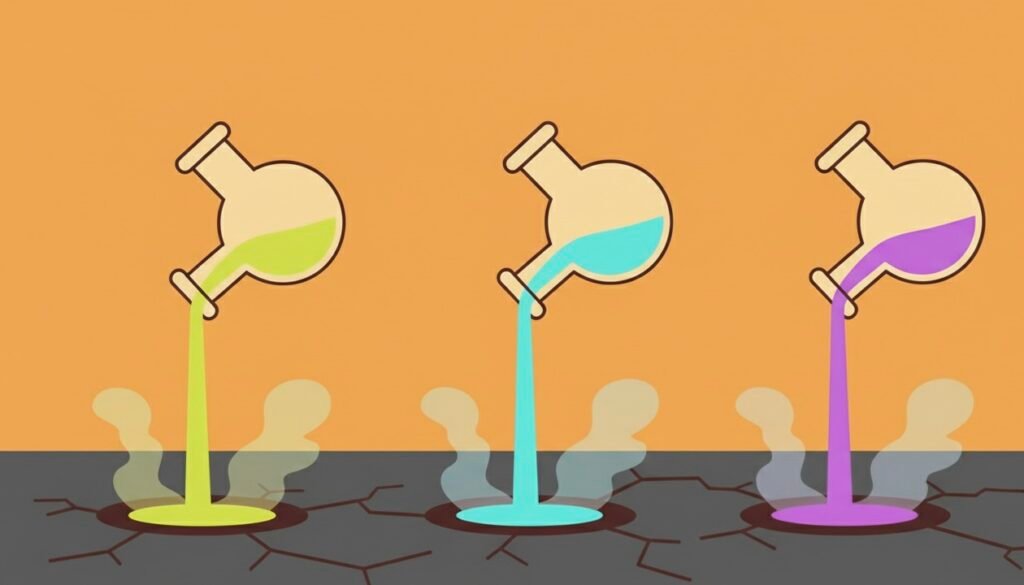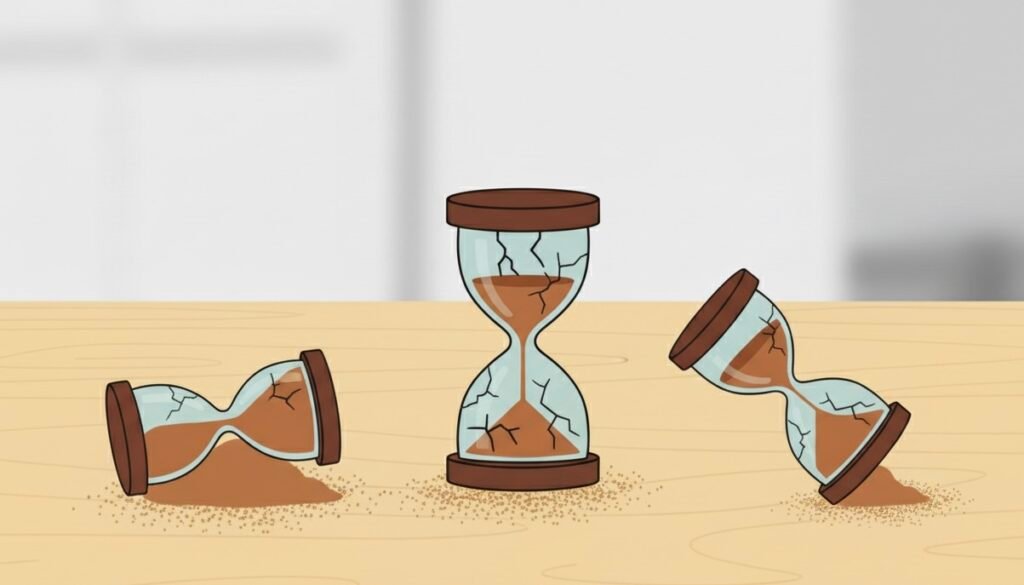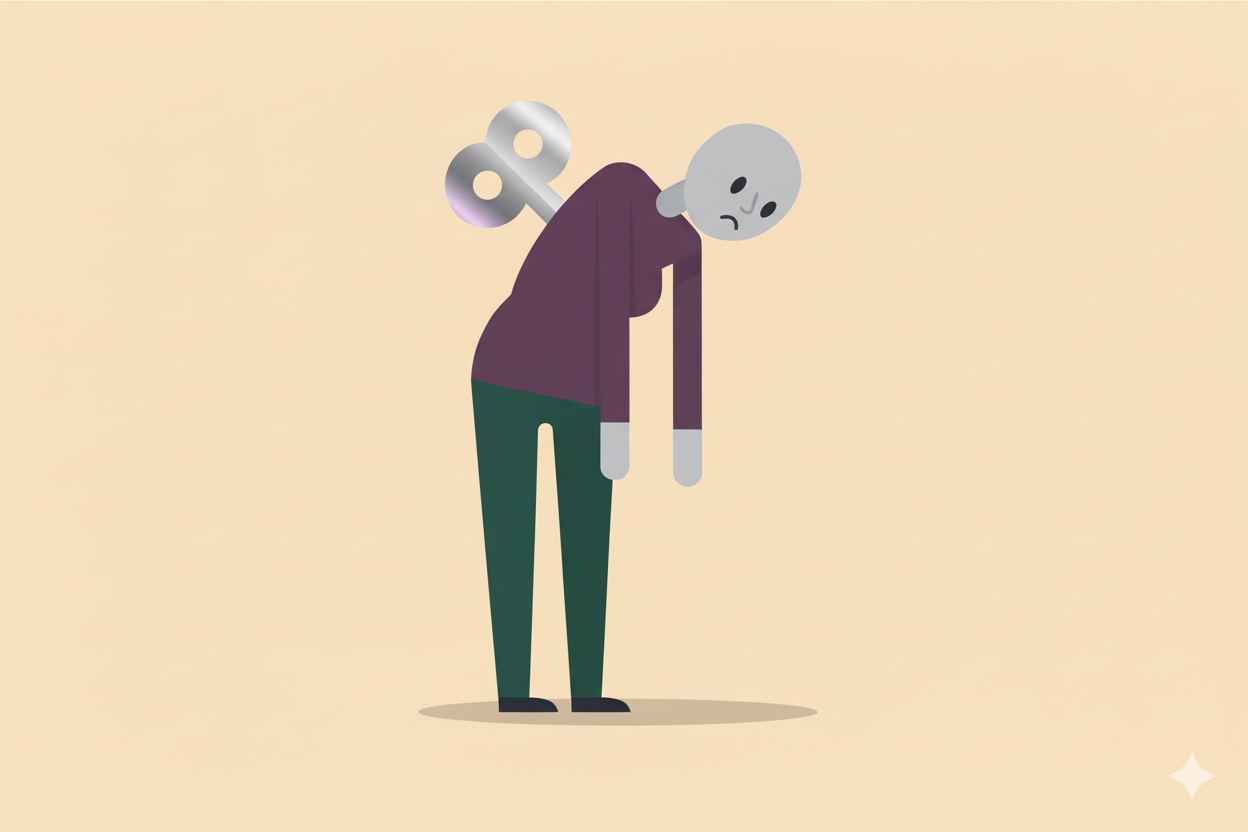Chronic pain fatigue is one of the most common but least understood symptoms. Beyond the pain itself, many people live with exhaustion and brain fog that affect daily life. This article explains why fatigue and mental clouding are so frequent in chronic pain and offers strategies that can help.

My Story: When Fatigue Meets Fog
I am a very active person. I used to go, when I was a teenager, to the countryside. Back then, my sister had a small farm, and we worked all day long. I fondly remember waking up at 4 a.m. when it was still dark outside and getting into the wagon, heading to the field. Fresh morning air, dew on vineyard leaves, stillness before sunrise and the smell of freshly worked soil. A feeling of satisfaction concluded the day. The hard work properly wore me out, but it was a good tiredness. The kind that at bedtime simply sinks into the mattress and leaves you abandoned to a deep, restoring sleep.
Now, since chronic pain has settled in, I cannot find my way to that type of tiredness anymore. Sometimes, when someone talks to me, I lose track of the conversation without realizing. Early in the day, I struggle to think clearly, to respond on time, and to disperse the fog so I can have a clear grasp of reality. When I am given more options, I get frustrated and cannot decide. On holidays or family visits, I become overwhelmed, stuck between plans. Multitasking and divided attention are not what they used to be.
Before the symptoms, I managed stress through activity: cleaning the house, exercising, playing sports like tennis or ping-pong, dancing, hiking. I can still do some of these, but always in a limited or altered way, never as freely as before, and with that, my ways of coping have been drastically reduced.
The hardest part, though, is feeling the constant drain on body and mind. Some mornings, as soon as I wake up, the weight of facing another day with pain makes me want to go back to bed. I’m not, because I’ve learned to turn to new strategies. They help me feel more energized and stay present with the people and moments that matter. I tell myself: you feel exhausted anyway, but at least this way you will feel satisfied that you took another step and not focus only on what pain can take away.
In the world of chronic pain, nothing is trivial, as even the smallest tasks can feel unreachable. However, I have good news for anyone who feels fatigued and foggy. We can do better, and I want to share today some practices that help me and others like us. Maybe you won’t clean the entire house, but doing the laundry may be enough. Grocery shopping might feel too much, but you can go buy bread and enjoy the walk there and back. Maybe you cannot work as much as you want, but, as Sebastian J. Cricket says in Guillermo del Toro’s Pinocchio: “you do your best, and that is the best that anyone can do.” Come along with me as I try to make sense of this, and let’s take one step at a time together.

Why Chronic Pain Drains Energy
Nervous system on high alert
Chronic pain keeps the nervous system in a constant state of hypervigilance. When the body is always expecting danger, stress hormones remain elevated. This ongoing “danger mode” consumes physical and mental resources, leaving little energy for daily activities.
Cortisol
- Normal role: cortisol regulates metabolism, controls blood sugar, and helps the body adapt to stress. In short-term situations, it boosts vitality and alertness.
- In chronic pain: cortisol remains abnormally high or fluctuates irregularly. This disrupts sleep, diminishes energy reserves, and causes mental fatigue by interfering with memory and concentration.
Adrenaline (epinephrine)
- Normal role: prepares the body for action by raising heart rate, increasing blood flow to muscles, and sharpening alertness.
- In chronic pain: instead of short bursts, adrenaline levels stay moderately high. The body stays tense, drains energy faster, and causes constant restlessness.
Noradrenaline (norepinephrine)
- Normal role: maintains attention, focus, and blood pressure during stress.
- In chronic pain: chronic overactivation contributes to difficulty concentrating, racing thoughts, and the sensation of brain fog.
Together, these hormonal changes explain why fatigue and brain fog persist even without obvious physical exertion.
Pain processing takes focus
Pain is not just a physical sensation; the brain processes it as a priority signal.
- Normal role: the brain uses its networks for attention, memory, and decision-making in daily life.
- In chronic pain: a large portion of these resources are redirected toward pain signals. This reduces working memory, slows mental processing, and makes ordinary tasks feel harder. The constant diversion of brain power contributes directly to fatigue and fog.
Inflammation and muscle strain
Chronic pain is often linked to low-grade inflammation and persistent muscle tension.
Inflammation
- Normal role: it is part of the immune system’s defense, designed to heal injury or fight infection.
- In chronic pain: inflammation can remain active even without injury. This disrupts energy production in cells, leading to persistent fatigue.
Muscle strain
- Normal role: muscles contract and relax as needed, conserving resources.
- In chronic pain: muscles stay partially contracted, bracing against pain. This constant tension uses power and produces soreness that deepens exhaustion.

Why Chronic Pain Causes Brain Fog
Recognizing brain fog
Brain fog is not a medical diagnosis but a collection of symptoms: poor focus, forgetfulness, slow thinking and mental fatigue. It is widely reported across conditions such as fibromyalgia and long-term low back pain, and is often explained by the mechanism of central sensitization.
Cognitive overload
- Normal role: the brain filters signals, allowing focus on important tasks while background signals are ignored.
- In chronic pain: pain signals bypass these filters and demand attention. The brain becomes overworked, leaving fewer resources for concentration and memory. This overload explains why reading, conversations or decision-making becomes more draining. See how central sensitization explains this overuse.
Emotional and mental fatigue
- Normal role: mental energy is conserved by alternating periods of activity and rest, and through a sense of safety.
- In chronic pain: constant hypervigilance – checking for pain, worrying about flare-ups or managing medical uncertainty – consumes this energy. The result is mental fatigue and cognitive fog, even on days with lower pain. Read more about the fear–pain cycle.

Beyond Sleep: Other Hidden Drains
Rest disruption is a major factor, but even when sleep is addressed, chronic pain fatigue and brain fog often remain.
Medications
- Normal role: pain relief or mood-stabilizing medications regulate the nervous system.
- In chronic pain: some medications cause side effects such as drowsiness, dizziness or slowed cognition, which add to fatigue and fog.
Mood strain
- Normal role: emotional regulation allows recovery between stressors.
- In chronic pain: ongoing frustration, anxiety or low mood create an additional energy drain, overlapping with physical fatigue.
Flare-ups
- Normal role: the body recovers after acute pain episodes.
- In chronic pain: flare-ups occur unpredictably, depleting both physical energy and mental resilience.
For detailed strategies on rest and recovery, see how chronic pain affects sleep and what helps.
Sensory sensitivity
- Normal role: the nervous system filters everyday input such as light, sound, and temperature changes.
- In chronic pain: sensory filtering weakens, so ordinary stimuli feel overwhelming. This constant input strains the system and increases fatigue.
Cognitive effort (decision fatigue)
- Normal role: the brain manages decisions efficiently, reserving mental resources for important tasks.
- In chronic pain: even small decisions require more effort because of pacing, planning and symptom management. This mental overwork accelerates exhaustion and fog.
Social demands
- Normal role: social interactions are usually neutral or restorative.
- In chronic pain: the need to explain, hide or “mask” symptoms adds emotional labor. This ongoing effort consumes energy and worsens fatigue.
Environmental stressors
- Normal role: a safe, calm environment supports recovery and rest.
- In chronic pain: noise, clutter or lack of a restful space keeps the nervous system in alert mode, preventing proper restoration.

Practical Tools for Fatigue and Brain Fog
Energy pacing
- What it is: dividing tasks into smaller steps and planning rest periods.
- Why it helps: prevents sudden crashes, spreads energy more evenly and allows for recovery between activities.
Micro-breaks and resets
- What it is: short pauses to stretch, breathe or rest attention.
- Why it helps: resets nervous system activity, clear mental fog and prevent overload.
Gentle movement
- What it is: walking, stretching or light mobility exercises.
- Why it helps: improves circulation, reduces muscle tension and supports cognitive clarity.
Calming the nervous system
- What it is: techniques like breathing exercises, mindfulness or relaxation practices.
- Why it helps: lowers cortisol and adrenaline levels, reducing both fatigue and brain fog in time.
Explore tools for calming the nervous system.
Community and support
- What it is: talking to safe, understanding people.
- Why it helps: reduces the emotional load and prevents isolation, which can worsen fatigue.
FAQs
Does chronic pain make you tired?
Yes, chronic pain fatigue results from hormonal stress changes, constant pain processing and inflammation.
Does anxiety make chronic pain fatigue worse?
Yes, anxiety keeps the body in a stressed state and prevents proper rest. Read more about anxiety and pain.
What does chronic pain do to the brain?
It redirects attention and memory resources toward pain signals, causing brain fog and slower processing.
Can chronic pain cause brain fog?
Yes. Difficulties with concentration, recall and clear thinking are common.
Can chronic pain make you feel sick?
Yes, fatigue often appears alongside nausea, indisposition and low resilience.
How do you get energy back with chronic pain?
Energy pacing, micro-breaks, gentle movement and calming practices help. For nighttime flare-ups, see the guide on what to do if you wake up in pain.
Chronic pain fatigue and brain fog can significantly interfere with daily life. Although they may not fully go away, many people find that their impact becomes more manageable over time with the right support and adjustments.
I hope something I’ve shared helps you rest a little better tonight. Stay curious, be kind to your body and give yourself room to slow down even when it’s hard.
If you got this far,
Get Support in Your Inbox
Subscribe to the newsletter and let me help you turn confusion into clarity. The PDF I have prepared is a guide that will help you organise all the elements of your condition: symptoms, treatments and impact, so you can understand your pain behaviour. This is truly important for explaining it to healthcare professionals, loved ones and yourself.
“Clinical Clarity Workbook–A map for precise diagnosis“
Until next time,
Alina

